Why Europe is falling behind in the race to build data centres
Data centre infrastructure is proceeding at an unprecedented rate, driven by the exponential growth in data generation. Countries and regions worldwide are actively competing to host the next generation of cloud and compute hubs, recognising their foundational role in the digital economy. However, while substantial investment and development activity are evident across the United States, Asia and the Middle East, Europe faces a distinct challenge, as it struggles to attract the same scale of investment into data centre construction. This disparity in development pace, inevitably raises questions about Europe's competitive position in the evolving digital infrastructure landscape – and people are now wondering – have they left it too late writes John Ridgeway?
The current surge in data centre construction is multifaceted. Fundamental drivers include the continuous growth of internet traffic, the widespread shift of enterprise operations to cloud-based services and the proliferation of big data analytics. The rise of AI and the Internet of Things (IoT) have also significantly amplified demand for processing power and storage. Large language models and AI training require intensive computing power, leading to a substantial increase in power density requirements within data centres. As a result, hyperscale operators, such as major cloud service providers, are investing heavily in new facilities to support these demands, often developing campuses with capacities reaching hundreds of megawatts.
Regions like North America, particularly the United States, have historically led in data centre capacity and continue to attract significant investment. Asia Pacific is experiencing rapid growth, fuelled by expanding digital economies, high smartphone adoption and increased e-commerce activity. Countries such as Singapore, China, Japan and India are seeing substantial investments from global cloud providers. The Middle East is also emerging as a key growth region, with various countries investing in digital infrastructure to diversify their economies. These regions frequently offer attractive conditions for large-scale data centre development, including available land, access to substantial power grids and supportive regulatory frameworks.
Europe's lag in hyperscale development
Despite robust demand for digital services within Europe, the continent has not yet secured the same volume of mega-scale data centre investments as other global counterparts. While Europe's "FLAP" markets (Frankfurt, London, Amsterdam, Paris) remain significant hubs and have experienced considerable growth in colocation capacity, the pace of true hyperscale campus development - facilities designed to exceed 100MW and serve global cloud providers directly - has been comparatively slower. This is not to say that Europe lacks data centres - indeed, the region hosts thousands of facilities, but the scale of new and extremely large deployments differs.
One of the most significant impediments to hyperscale data centre growth in Europe is power availability and grid capacity. Large data centres require substantial and reliable power supplies. In many established European markets, existing power grids are already strained and securing new, high-capacity connections can involve lengthy lead times and significant costs. Some local jurisdictions, such as Amsterdam and parts of Ireland, have even implemented moratoria or restrictions on new data centre developments to alleviate pressure on power grids. While Europe is committed to transitioning to renewable energy sources, the infrastructure to deliver this renewable power reliably and at the scale required for hyperscale facilities remains a considerable challenge in many areas.
Land availability and cost represent another constraint. Densely populated urban areas, where demand for digital services is highest, offer limited suitable land parcels for large-scale data centre campuses. Land costs in prime European locations can be substantially higher compared to regions in the United States or emerging markets in Asia and the Middle East. Identifying and acquiring large, well-connected sites with sufficient power and fibre optic infrastructure presents a consistent hurdle.
The regulatory and permitting environment in Europe is also often more complex and fragmented than in other regions. Varying national and even local regulations concerning environmental impact, energy efficiency, data sovereignty and permitting processes can introduce significant bureaucratic burdens, delays and uncertainty for developers. While Europe's commitment to sustainability is strong, ambitious targets under initiatives like the Climate Neutral Data Centre Pact (CNDCP) and the EU Energy Efficiency Directive, while laudable, add layers of compliance that can impact project timelines and costs. New regulations requiring heat reuse and stricter reporting obligations can further necessitate additional investment and design complexity.
Rising construction costs and supply chain issues also impact European data centre development. The cost of materials, labour and specialized equipment has increased globally, but regional variations in supply chain resilience and labour availability can exacerbate these issues in Europe. Less predictable development timelines due to these factors make it challenging for developers to commit to fixed budgets and delivery schedules.
While Europe possesses a highly skilled workforce, intense competition for specialised technical talent within the data centre industry can lead to shortages. The demand for engineers, technicians and operations staff proficient in modern data centre technologies, including AI-optimised infrastructure and sustainable cooling solutions, often outstrips supply, contributing to higher operational costs.
Lastly, data sovereignty and localisation requirements, while intended to protect citizen data, can influence data centre siting strategies. Companies may be required to store certain types of data within specific national or regional borders, which, while supporting local colocation markets, can sometimes disincentivise the consolidation of massive hyperscale operations into a single pan-European hub, potentially favouring a distributed model instead.
Europe's existing strengths
Despite these challenges, Europe remains a critical market for digital infrastructure. The region has a large and digitally advanced economy, strong demand for cloud services and a commitment to data protection and sustainability. The European data centre market continues to grow, albeit with a different trajectory than other global hotspots.
European data centre operators and investors are adapting to the prevailing conditions. There is a growing trend towards exploring secondary markets within Europe that offer more accessible power, land availability and potentially more streamlined permitting processes. Countries in the Nordics (e.g., Sweden, Norway) benefit from colder climates, reducing cooling costs and access to abundant renewable energy. Southern European countries like Spain, Portugal, and Greece are also gaining interest due to their potential for renewable energy generation and competitive land prices.

Furthermore, there is an increasing trend of hyperscale cloud providers using colocation and build-to-suit models with regional European data centre operators rather than solely building their own facilities. This approach allows them to navigate local complexities more effectively by partnering with entities that possess deep local knowledge of power grids, land permitting and regulatory landscapes. This shift creates significant opportunities for established European colocation providers to scale their operations and meet hyperscale demand.
Efforts are also underway to address the power challenge. Initiatives focusing on improving energy efficiency within data centres, increasing the adoption of renewable energy sources, and exploring heat reuse projects are gaining traction. Regulations like the EU Energy Efficiency Directive are pushing for greater transparency and mandating heat reuse, fostering innovation in this area. The Climate Neutral Data Centre Pact, a voluntary initiative, signifies the industry's commitment to achieving climate neutrality by 2030 through sustainable practices.
The path forward for Europe
For Europe to attract more mega-scale data centre investment, a concerted effort is required across various fronts. Streamlining and harmonising regulatory processes across member states could reduce the administrative burden and increase investment certainty. Strategic investment in power grid upgrades and expansion, particularly for renewable energy integration, is essential to meet the escalating power demands of hyperscale facilities. Collaboration between governments, utility providers, and the data centre industry will be critical in identifying suitable land parcels and developing the necessary infrastructure.
While Europe may not be replicating the exact hyperscale growth patterns of the U.S. or parts of Asia, its focus on sustainability, data sovereignty and a distributed network of high-quality facilities reflects its distinct market characteristics and regulatory environment. The continent's future in digital infrastructure lies in leveraging its strengths - a sophisticated digital economy, a strong emphasis on data governance and a growing commitment to green energy - while proactively addressing the existing bottlenecks in power, land and regulatory complexity. This strategic adaptation will ensure Europe remains a competitive and vital component of the global digital landscape, even if its hyperscale footprint evolves differently in other major regions.
Additional Blogs

Construction’s obsession with blame instead of learning
Construction is one of the most technically advanced industries in the built environment, yet culturally it often behaves like one of the least reflective. When things go wrong and they frequently...
Read moreHow risk Is routinely pushed down the supply chain
Risk is an unavoidable part of construction. Every project involves uncertainty around ground conditions, weather, design coordination, procurement, labour and programme. Yet while risk is inherent,...
Read more

What if Building Control went fully digital?
Building control governs structural integrity, fire protection, energy efficiency, accessibility and countless other aspects of design and construction. Historically, this process has been highly...
Read more